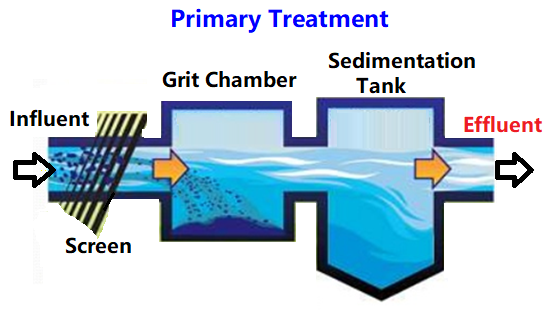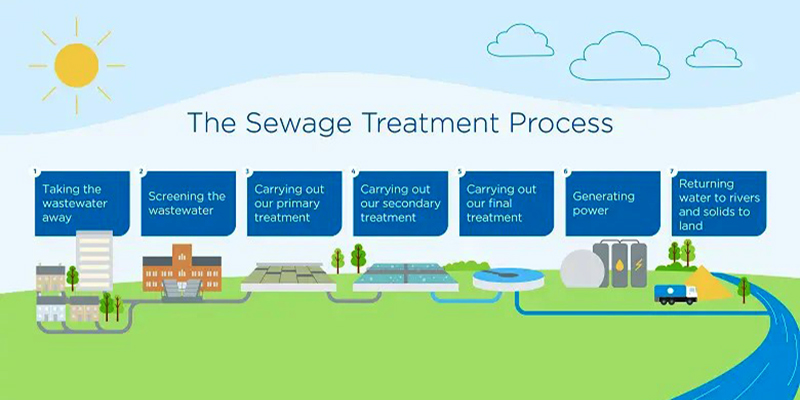Sewage treatment is a complex and essential process designed to remove pollutants and contaminants from wastewater, ensuring that it is safe to discharge into the environment or suitable for reuse. Let’s delve into each step of this intricate process in detail:
Screening
The sewage treatment process typically begins with screening. Wastewater flows through screens, which capture large objects such as sticks, rags, plastics, and other debris. These screenings prevent these materials from entering subsequent treatment processes, thereby protecting pumps, pipes, and other equipment from damage.
Screens used in sewage treatment facilities vary in design and configuration depending on factors such as the size of the wastewater treatment plant, flow rate, and types of contaminants present.
Bar screens consist of closely spaced vertical bars arranged in a parallel or inclined configuration. Debris is trapped on the upstream side of the bars and manually or mechanically raked off for disposal.
Mesh screens, also known as drum screens or fine screens, use rotating drums or panels with fine mesh openings to capture smaller debris particles. These screens are effective at removing finer materials but may require more maintenance due to clogging.
Grit Removal
Following screening, the wastewater undergoes grit removal to eliminate heavy inorganic solids such as sand, gravel, and grit. This is achieved in grit chambers, where the flow velocity is reduced, allowing these heavier particles to settle to the bottom under gravity. Grit chambers are designed with a horizontal or vertical flow pattern to facilitate the settling of heavy solids. Horizontal flow grit chambers typically have a longer detention time, allowing for more efficient grit removal
Grit removal is crucial as it prevents abrasion and wear in downstream equipment, ensuring their efficient operation. By removing grit, sewage treatment plants can minimize maintenance costs, extend the lifespan of equipment, and ensure the efficient operation of subsequent treatment stages.
Primary Treatment
The pre-treated wastewater then enters primary clarifiers, large tanks where the velocity of flow is reduced significantly, allowing suspended solids and organic matter to settle out. This primary settling process, facilitated by gravity, results in the separation of sludge (primary sludge) from the wastewater. Primary treatment removes a significant portion of the suspended solids and organic matter, although it may not be sufficient for meeting stringent effluent standards on its own.
By removing these contaminants, primary treatment helps prevent clogging of downstream treatment processes, protects biological treatment systems from shock loads, and improves the overall efficiency of the treatment plant.

Biological Treatment (Secondary Treatment)
Following primary treatment, the partially treated wastewater undergoes biological treatment to further break down organic pollutants and remove nutrients. This biological treatment stage employs microorganisms, such as bacteria and protozoa, which metabolize organic matter as a food source, converting it into simpler substances like carbon dioxide, water, and biomass.
Common biological treatment processes include activated sludge systems, where wastewater is mixed with a suspension of microorganisms in aeration tanks, and trickling filters, where wastewater is trickled over a medium (such as rock or plastic) coated with microbial biofilm.

Secondary Clarification
Secondary clarification, also known as secondary sedimentation, is a critical step in sewage treatment that follows biological treatment processes. It involves the separation of biological floc (biomass) and remaining suspended solids from the treated wastewater (secondary effluent) after biological treatment.
Secondary clarification typically occurs in large tanks called secondary clarifiers or secondary settling tanks, which are similar in design to primary clarifiers but are specifically designed to handle the effluent from biological treatment processes. Treated wastewater (secondary effluent) from the biological treatment stage is directed into the secondary clarifiers, where the flow velocity is reduced to allow settling of suspended solids and biomass. As the effluent flows through the secondary clarifier, gravity causes the denser biomass and suspended solids to settle to the bottom of the tank, forming a sludge layer, while the clarified effluent rises to the surface.
Tertiary Treatment (Optional)
Tertiary treatment may be employed to further enhance the quality of the effluent, particularly if it is intended for discharge into sensitive environments or for reuse purposes. Tertiary treatment processes include advanced filtration techniques such as sand filtration, membrane filtration, or chemical treatment methods like chlorination, ozonation, or UV disinfection.
Disinfection
Before discharge or reuse, the treated wastewater undergoes disinfection to eliminate any remaining pathogens (such as bacteria, viruses, and protozoa), ensuring it meets regulatory standards for public health protection. Common disinfection methods include chlorination, where chlorine-based chemicals are added to the wastewater, UV irradiation, which exposes the wastewater to ultraviolet light, and ozonation, where ozone gas is bubbled through the wastewater.

Sludge Treatment and Disposal
Throughout the sludge treatment process, sludge is generated as a byproduct. This sludge undergoes further treatment to stabilize it, reduce its volume, and make it suitable for disposal or beneficial reuse. Treatment methods include anaerobic digestion, where microorganisms break down organic matter in the absence of oxygen, and aerobic digestion, where organic matter is decomposed by aerobic bacteria in the presence of oxygen.
Once treated, the sludge may be dewatered to remove excess water, thermally dried to reduce its moisture content, and ultimately disposed of in landfills, incinerated, or beneficially reused as fertilizer or soil conditioner, which will be fully explained in the next article.
Effluent Discharge or Reuse
Finally, the treated wastewater, now meeting regulatory standards and free of harmful contaminants, is either discharged into receiving water bodies such as rivers, lakes, or oceans, or reused for non-potable purposes such as irrigation, industrial processes, or environmental restoration projects.
In summary, sewage treatment involves a series of interconnected steps, each essential for effectively treating wastewater and minimizing its environmental impact. Through careful implementation of these treatment processes and adherence to stringent quality standards, sewage treatment facilities play a critical role in safeguarding public health and protecting the environment.
For expert advice and consulting services tailored to your sewage treatment needs, please don’t hesitate to contact us. We’re here to help you achieve efficient and effective wastewater management solutions for your facility.


[…] activities before it is discharged into the environment or reused within the facility. The treatment aims to reduce or eliminate pollutants to meet regulatory standards, protect public health, and […]